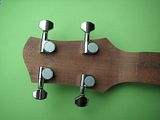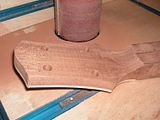Mike Wingate
Established Member
I have seen some purpose built thickness sanders, but needed to get this job done. I used to use the lathe with a bed setup and the sanding drum in a chuck, but stuff is in the way. So my drill table fence came in handy. I went for a low fence and there was enough support to sand the back of this ukulele head[URL=http://s130.photobucket.com/al...ingate_52/Ukulele Build/th_PICT0104.jpg[/img][/url]


































